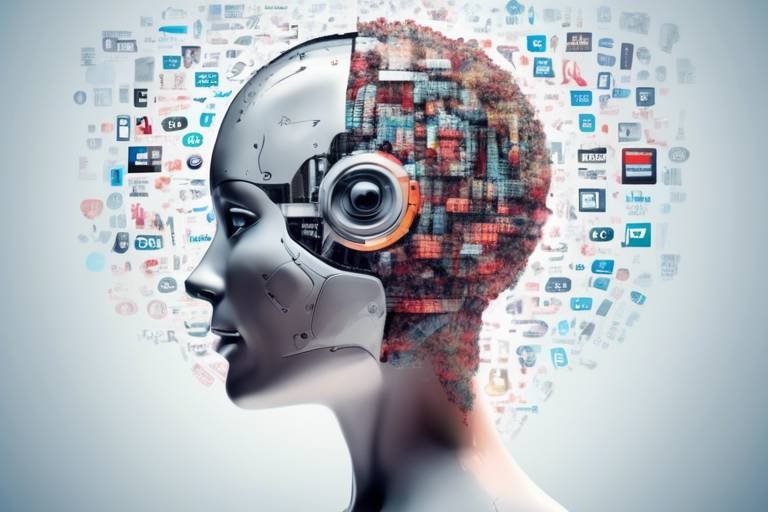AI in Radio: How Technology is Revolutionizing Radio Broadcasting
In the ever-evolving landscape of media, one of the most exciting transformations is happening in radio broadcasting, largely driven by the advent of artificial intelligence (AI). Gone are the days when radio was merely a platform for music and talk shows. Today, AI is reshaping how we create, distribute, and engage with audio content. Imagine a world where your favorite radio station knows exactly what you want to listen to, when you want to listen to it, and even engages you in real-time discussions. Sounds like science fiction? Well, it’s becoming a reality!
The integration of AI into radio is not just about automation; it's about enhancing the entire listener experience. From personalized playlists that cater to your mood to automated news reporting that keeps you updated on current events, AI is making radio more relevant and engaging than ever before. This article delves into the transformative role of AI in radio broadcasting, highlighting its impact on content creation, audience engagement, and operational efficiency.
To understand the current revolution, we must look back at the historical development of radio broadcasting. Radio has come a long way since its inception in the early 20th century. Initially, it was a one-way communication tool, primarily used for news and entertainment. As technology progressed, so did the methods of broadcasting. The introduction of FM radio in the 1960s brought about better sound quality, while the digital age in the late 1990s ushered in internet radio, allowing listeners to access content from anywhere in the world.
Today, we find ourselves at the brink of a new era, where AI plays a crucial role. The journey from traditional radio to the integration of advanced technologies like AI has been nothing short of remarkable. With AI, radio stations now have the ability to analyze vast amounts of data, automate content creation, and engage audiences in ways that were previously unimaginable. This evolution is not just a trend; it’s a fundamental shift in how we consume audio content.
One of the most significant impacts of AI in radio is in content creation. AI tools are revolutionizing how radio stations produce and deliver content, enabling them to provide personalized programming that resonates with listeners. Imagine a radio show that adapts its content based on real-time listener feedback! This is now possible thanks to AI.
Consider how AI algorithms can generate real-time news reports, ensuring that listeners receive timely and accurate information. This not only keeps audiences informed but also frees up human resources for more creative tasks. Instead of spending hours sifting through news articles, AI can quickly compile relevant information and present it in a digestible format. This automation allows radio hosts to focus on what they do best: engaging with their audience.
AI also plays a pivotal role in analyzing listener data to identify trends and preferences. By understanding what listeners enjoy, radio stations can tailor their content to improve audience satisfaction. For example, if data shows that a particular genre is gaining popularity, stations can adjust their playlists accordingly. This data-driven approach not only enhances the listener experience but also drives higher engagement rates.
Moreover, AI tools assist in audio editing and production, streamlining processes and enhancing sound quality. Imagine having a virtual assistant that can edit your audio files, remove background noise, and even suggest improvements to your recordings. This technology is making audio production more accessible, allowing even small stations to produce high-quality content without breaking the bank.
Another exciting aspect of AI in radio is its ability to customize experiences for listeners. With AI, stations can deliver tailored playlists and recommendations based on individual preferences. This personalization goes beyond just song selection; it creates a unique listening journey for each individual. Think of it as having a personal DJ who knows your musical taste inside and out!
AI is not only transforming content creation but also revolutionizing how audiences engage with radio. Innovative ways of interaction are emerging, making the listener experience more dynamic and participatory. From chatbots that answer listener queries to social media integration that keeps audiences connected, AI is fostering a more engaged listener community.
Imagine being able to influence the programming of your favorite radio show in real-time! AI facilitates this kind of audience participation, allowing listeners to interact with hosts and contribute to discussions. This level of engagement creates a sense of community among listeners, making radio feel more like a conversation than a broadcast.
Furthermore, AI plays a crucial role in managing social media platforms for radio stations. By analyzing engagement metrics, AI can help stations understand what content resonates with their audience, allowing for more effective promotion and connection. This integration not only boosts visibility but also helps create a loyal listener base.
As with any technological advancement, the use of AI in radio comes with its own set of challenges and ethical considerations. It's essential to address these issues to ensure that the benefits of AI are realized without compromising listener trust.
One of the primary concerns is data privacy. With AI analyzing listener data, radio stations must take measures to safeguard this information and comply with privacy regulations. Ensuring that listener data is protected is not just a legal obligation; it’s a moral responsibility that builds trust between stations and their audiences.
Another significant concern is the potential for bias in AI algorithms. If not carefully monitored, AI can inadvertently promote content that lacks diversity, impacting the richness of programming. It's crucial for radio stations to prioritize transparency and accountability in their AI applications to ensure that all voices are heard.
- How is AI used in radio broadcasting? AI is used for content creation, audience engagement, and operational efficiency, enhancing the overall listener experience.
- Can AI create personalized playlists? Yes, AI analyzes listener preferences to deliver tailored playlists that cater to individual tastes.
- What are the ethical concerns surrounding AI in radio? Key concerns include data privacy and the risk of bias in content delivery.
- How does AI enhance audience engagement? AI facilitates real-time interaction, allowing listeners to participate in programming and connect with hosts.

The Evolution of Radio Broadcasting
Radio broadcasting has come a long way since its inception in the early 20th century. Initially, it was a rudimentary form of communication, primarily used for transmitting Morse code messages. However, as technology progressed, radio evolved into a powerful medium for entertainment and information dissemination. The journey from those humble beginnings to today's AI-driven platforms is nothing short of fascinating.
In the 1920s, commercial radio stations began to emerge, and the airwaves were filled with music, news, and drama. This era marked the golden age of radio, where families would gather around their radios, eagerly awaiting their favorite shows. The introduction of FM radio in the 1930s significantly improved sound quality, making it a preferred choice for listeners. It wasn’t long before radio became an integral part of everyday life, shaping culture and influencing public opinion.
Fast forward to the late 20th century, when the advent of digital technology began to transform the landscape of radio broadcasting. The introduction of digital audio broadcasting (DAB) provided clearer sound and more channels, allowing listeners to enjoy a wider variety of programming. This period also saw the rise of satellite radio, which offered commercial-free music and niche content that traditional radio could not provide.
Today, we find ourselves in the age of the internet, where streaming platforms have revolutionized how we consume audio content. Listeners can access their favorite stations from anywhere in the world, and on-demand content has become the norm. With the rise of podcasts, radio has expanded its reach and transformed into a more personalized experience.
As we embrace the digital era, the integration of artificial intelligence into radio broadcasting is the next big leap forward. AI technologies are not only enhancing the quality of content but also streamlining operations and improving audience engagement. This transformation raises intriguing questions about the future of radio: Will traditional broadcasting methods become obsolete? How will AI shape the content we consume?
To better understand this evolution, let’s take a look at some key milestones in the history of radio broadcasting:
| Year | Milestone |
|---|---|
| 1906 | First radio broadcast of voice and music by Reginald Fessenden |
| 1920 | First commercial radio station, KDKA, begins broadcasting in Pittsburgh |
| 1933 | FM radio is developed, improving sound quality |
| 1949 | First satellite radio transmission |
| 2000s | Rise of internet radio and podcasting |
| 2020s | Integration of AI in content creation and audience engagement |
The evolution of radio broadcasting is a testament to the power of innovation and adaptability. As technology continues to advance, we can only imagine how AI will further transform this beloved medium. The next section will delve into how AI-driven content creation is reshaping the way we experience radio.

AI-Driven Content Creation
In the ever-evolving landscape of radio broadcasting, artificial intelligence is emerging as a game-changer, particularly in the realm of content creation. Imagine a world where radio stations can effortlessly produce engaging content tailored to the tastes and preferences of their listeners. Well, that world is already here! AI tools are not just a futuristic concept; they are actively transforming how radio content is created, curated, and delivered.
One of the most significant advancements is the automation of routine tasks, which allows human creators to focus on what they do best—being creative! By utilizing AI-driven algorithms, radio stations can automate mundane processes such as scriptwriting, audio editing, and even scheduling broadcasts. This means that content can be produced at lightning speed without sacrificing quality. For instance, AI can analyze listener feedback and adjust programming accordingly, ensuring that what airs is not only timely but also resonates with the audience.
Consider the traditional methods of news reporting in radio. Journalists would spend hours gathering information, writing scripts, and recording segments. Now, with AI algorithms, news reporting has been revolutionized. These intelligent systems can scan multiple sources of information in real-time, generating news reports with incredible speed and accuracy. This not only ensures that listeners receive up-to-the-minute news but also allows radio stations to allocate their human resources to more creative pursuits, like developing unique segments or engaging interviews.
Another fascinating aspect of AI in content creation is its ability to provide data-driven insights. By analyzing listener data—such as listening habits, feedback, and preferences—AI can identify trends that help stations tailor their content. For example, if data shows that listeners prefer a particular genre or topic, stations can adjust their programming to meet these preferences. This level of customization enhances audience satisfaction and fosters a loyal listener base.
When it comes to audio production, AI tools are proving to be invaluable. They assist in audio editing, sound mixing, and mastering, making the production process more efficient. Imagine having an AI assistant that can enhance audio quality, eliminate background noise, and even suggest sound effects or music tracks that fit the mood of a segment. This not only saves time but also elevates the overall listening experience. With AI, radio stations can ensure that every broadcast sounds polished and professional.
In summary, AI-driven content creation is not just about efficiency; it's about enhancing the overall quality and relevance of radio programming. By automating routine tasks, generating real-time news, analyzing listener preferences, and improving audio production, AI is paving the way for a new era in radio broadcasting. As we continue to embrace these technologies, the potential for innovation in content creation is limitless, promising a more engaging and personalized experience for listeners everywhere.
- How is AI used in content creation for radio? AI is used to automate routine tasks, generate real-time news reports, analyze listener data, and assist in audio production.
- What are the benefits of AI in radio broadcasting? The benefits include increased efficiency, enhanced content quality, personalized listener experiences, and the ability to quickly adapt to audience preferences.
- Are there any challenges associated with using AI in radio? Yes, challenges include data privacy concerns and the potential for bias in AI algorithms, which can affect content diversity.

Automated News Reporting
In the fast-paced world of radio broadcasting, timeliness is everything. Audiences crave the latest news, and they want it delivered as quickly as possible. That’s where comes into play, revolutionizing how news is gathered, produced, and shared. Imagine a scenario where algorithms work tirelessly behind the scenes, sifting through vast amounts of data, identifying breaking news, and generating reports—all in real-time. This technology not only enhances the efficiency of news delivery but also ensures that listeners receive accurate and up-to-date information without the delays associated with traditional reporting methods.
AI algorithms are designed to analyze various data sources, including social media feeds, news websites, and even live broadcasts, to capture the essence of breaking stories. Once a significant event is detected, these systems can automatically draft news articles, complete with relevant details and context. For example, during a major event like a natural disaster or a political upheaval, AI can quickly compile reports that include:
- Key facts: Who, what, where, and when.
- Quotations: Pulling in statements from eyewitnesses or official sources.
- Contextual background: Providing historical context to help listeners understand the significance of the news.
This automation not only speeds up the reporting process but also allows human journalists to focus on more creative and analytical tasks. Instead of spending hours writing up a report, they can delve deeper into investigative journalism or provide expert commentary. The result? A richer, more engaging news experience for the audience.
Moreover, automated news reporting systems can be programmed to adhere to the station's unique voice and style, ensuring that even machine-generated content feels authentic and consistent with the station's brand. As AI continues to evolve, we can expect these systems to become even more sophisticated, learning from past reports and audience feedback to enhance their output further.
However, while the benefits are clear, it’s crucial to address the potential downsides. Automated systems must be carefully monitored to prevent the spread of misinformation. If not properly managed, there’s a risk that erroneous data could lead to inaccurate news reports, undermining the trust that listeners place in their favorite stations. As we embrace this technological shift, striking a balance between automation and human oversight will be key to maintaining credibility in news reporting.
In conclusion, automated news reporting is not just a trend; it’s a fundamental shift in how radio stations operate. By leveraging AI technologies, broadcasters can deliver timely, accurate, and engaging news to their audiences, all while allowing human journalists to focus on what they do best—telling compelling stories.
- What is automated news reporting? Automated news reporting uses AI algorithms to gather, analyze, and generate news articles quickly and efficiently.
- How does AI ensure the accuracy of news reports? AI systems analyze multiple data sources and can be programmed to follow specific guidelines to maintain accuracy, but human oversight is essential to verify the information.
- Can AI replace human journalists? While AI can automate routine reporting tasks, it cannot replace the creativity, intuition, and depth of insight that human journalists provide.

Data-Driven Insights
In today's fast-paced digital world, the ability to harness has become a game changer for radio broadcasting. With the integration of artificial intelligence, radio stations can now analyze vast amounts of listener data to uncover trends and preferences that were previously hidden. This transformation not only enhances the overall listening experience but also empowers stations to create content that resonates deeply with their audience.
Imagine a radio station that knows exactly what its listeners want to hear. By utilizing AI algorithms, stations can sift through listener behaviors, including what songs they play most often, the times they tune in, and the types of shows they prefer. This data can be visualized in various forms, such as charts or tables, allowing station managers to make informed decisions about programming. For instance, a simple table might illustrate the correlation between time slots and listener engagement:
| Time Slot | Average Listeners | Most Played Genre |
|---|---|---|
| 6 AM - 9 AM | 1,500 | Pop |
| 9 AM - 12 PM | 2,000 | Rock |
| 12 PM - 3 PM | 1,800 | Hip-Hop |
| 3 PM - 6 PM | 2,500 | Electronic |
This table not only highlights the peak listening times but also indicates which genres are most popular during those hours. By leveraging these insights, stations can tailor their playlists and programming schedules to maximize engagement and listener satisfaction.
Moreover, AI doesn't just stop at analyzing data; it also helps in predicting future trends. By examining historical data, AI can forecast what types of content are likely to gain popularity, allowing radio stations to stay ahead of the curve. This proactive approach can be likened to having a weather forecast for your programming decisions—knowing when to play that upcoming hit before it even becomes mainstream.
But it’s not just about the numbers; it's about creating a personal connection with the audience. AI can segment listeners into various demographics, enabling stations to craft targeted marketing strategies and personalized content. For example, a station might discover that younger listeners prefer upbeat tracks in the morning, while older audiences enjoy classic hits during the afternoon. This nuanced understanding of listener preferences fosters a deeper connection and loyalty to the station.
In conclusion, data-driven insights powered by AI are revolutionizing the radio industry. By transforming raw data into actionable strategies, radio stations can not only enhance their programming but also create a more engaging and personalized experience for their listeners. As we continue to explore the potential of AI in radio, one thing is clear: the future of broadcasting is bright, and it's fueled by data.
- How does AI improve radio content? AI analyzes listener data to tailor content, ensuring it resonates with audience preferences.
- What types of data are most useful for radio stations? Listener behavior, demographic information, and engagement metrics are key data points for effective programming.
- Can AI predict music trends? Yes, AI can analyze historical data to forecast upcoming trends, helping stations stay relevant.
- Are there privacy concerns with listener data? Absolutely. Stations must prioritize data privacy and comply with regulations to protect listener information.

Creative Audio Production
In the world of radio broadcasting, the creative process has always been a crucial element, shaping the sound and feel of stations worldwide. With the advent of artificial intelligence, this process is being transformed in ways that were once unimaginable. AI tools are now stepping in to assist audio producers, enabling them to create high-quality content more efficiently than ever before. Imagine a world where tedious audio editing tasks are handled by smart algorithms, allowing creative minds to focus on what they do best—crafting engaging stories and sounds.
One of the most exciting aspects of AI in audio production is its ability to enhance sound quality. By utilizing advanced algorithms, AI can analyze audio tracks and make real-time adjustments to improve clarity and balance. This not only saves time but also elevates the overall listening experience for audiences. For instance, AI can automatically adjust levels, remove background noise, and even enhance vocal clarity, making every broadcast sound professionally polished without the need for extensive manual intervention.
Furthermore, AI-driven tools can assist in the creation of unique audio effects. Producers can experiment with different soundscapes and effects that AI generates based on listener preferences and trends. This means that radio stations can offer a more tailored auditory experience, keeping listeners engaged and coming back for more. AI can analyze which sound effects resonate most with audiences, providing valuable insights that guide producers in their creative decisions.
To illustrate the impact of AI on creative audio production, consider the following table that outlines key benefits:
| Benefit | Description |
|---|---|
| Time Efficiency | AI automates routine editing tasks, allowing producers to focus on creativity. |
| Sound Quality Enhancement | Real-time adjustments improve audio clarity and balance. |
| Creative Experimentation | AI generates unique sound effects based on listener trends. |
| Data-Driven Insights | AI analyzes listener preferences to guide creative decisions. |
Moreover, AI can also assist in content curation. By analyzing vast amounts of data, AI can suggest themes, music tracks, and sound bites that align with current trends or specific audience demographics. This not only streamlines the production process but also ensures that the content resonates with listeners. For instance, if a particular genre of music is trending among listeners, AI can recommend incorporating that into upcoming shows, thereby enhancing audience satisfaction.
In conclusion, the integration of AI in creative audio production is not just a technological advancement; it is a revolution that is reshaping the radio landscape. With AI's ability to enhance sound quality, automate tedious tasks, and provide data-driven insights, radio producers can unleash their creativity like never before. As we move forward, the collaboration between human creativity and artificial intelligence promises to create an even richer auditory experience for listeners around the globe.
- How does AI improve audio quality in radio production? AI enhances audio quality by analyzing and making real-time adjustments to sound levels, clarity, and background noise.
- Can AI replace human audio producers? While AI can automate many tasks, it complements human creativity rather than replacing it, allowing producers to focus on storytelling and content creation.
- What are the ethical implications of using AI in radio? Ethical concerns include data privacy and the potential for bias in AI algorithms, which radio stations must address to ensure fair content delivery.

Personalized Listener Experiences
The world of radio broadcasting is evolving at an astonishing pace, and one of the most exciting developments is the rise of . Imagine tuning into your favorite radio station and instantly receiving a playlist that feels like it was crafted just for you. This is not just a dream; it's a reality made possible by the power of artificial intelligence. AI algorithms analyze your listening habits, preferences, and even the time of day to curate a unique audio experience that resonates with your personal taste.
With AI, radio stations can offer tailored content that goes beyond just music. For instance, if you frequently listen to news segments during your morning commute, AI can prioritize these updates in your personalized feed. This means that instead of sifting through hours of content, you get a curated selection that keeps you informed and entertained. The beauty of this technology lies in its ability to adapt and learn from your preferences over time, creating a truly dynamic listening experience.
Moreover, AI can enhance the interactivity of radio shows. Picture this: you're listening to a live broadcast, and you receive a notification on your phone inviting you to vote on the next song or topic of discussion. This level of engagement transforms passive listening into an active experience, making you feel like a vital part of the show's direction. It's a bit like being at a concert where you can influence the setlist—how cool is that?
In addition to music and talk shows, AI can also personalize advertisements. Traditional radio ads often miss the mark because they are one-size-fits-all. However, with AI, advertisers can deliver messages that are relevant to your interests, increasing the chances of engagement. For example, if you frequently listen to health and wellness podcasts, you might hear ads for local gyms or health food stores, making the ads feel less intrusive and more like helpful suggestions.
To illustrate the impact of personalized listener experiences, consider the following table that compares traditional radio broadcasting with AI-driven personalized experiences:
| Feature | Traditional Radio | AI-Driven Radio |
|---|---|---|
| Content Curation | Generic playlists | Personalized playlists based on listener preferences |
| Listener Engagement | Passive listening | Active participation through real-time voting and feedback |
| Advertising | One-size-fits-all ads | Targeted ads relevant to individual interests |
| Feedback Mechanism | Limited listener feedback | Continuous learning from listener behavior |
In conclusion, the integration of AI into radio broadcasting is not just a technological advancement; it is a game-changer for how we experience audio content. By personalizing listener experiences, radio stations can foster deeper connections with their audiences, ensuring that each listener feels valued and understood. As we continue to embrace these innovations, the future of radio promises to be more engaging, interactive, and tailored than ever before.
- How does AI personalize my listening experience? AI analyzes your listening habits and preferences to create customized playlists and content recommendations.
- Can I influence the content I hear on the radio? Yes! Many AI-driven platforms allow listeners to participate in real-time decisions about programming and content.
- Are personalized ads really more effective? Absolutely! Personalized ads are tailored to your interests, making them more relevant and engaging.
- What happens to my data? Radio stations must comply with data privacy regulations to ensure your data is protected and used responsibly.

Enhancing Audience Engagement
In the vast ocean of radio broadcasting, where countless voices compete for attention, audience engagement has become the lifeblood of successful stations. With the advent of artificial intelligence, radio has undergone a significant transformation, enabling stations to connect with their listeners in ways that were once unimaginable. Imagine a world where your favorite radio station not only plays your preferred songs but also interacts with you in real-time, making you feel like a valued member of a vibrant community. This is no longer a dream; it's the new reality brought to life by AI.
AI technologies are now at the forefront of enhancing listener interaction. For instance, chatbots have emerged as a powerful tool for radio stations, serving as virtual assistants that can answer listener queries, provide information about upcoming shows, or even take song requests. These chatbots operate 24/7, ensuring that listeners can engage with their favorite stations at any time. It's like having a personal radio assistant right at your fingertips! The integration of AI in this way not only improves the listener experience but also frees up human resources to focus on more creative aspects of broadcasting.
One of the most exciting developments in enhancing audience engagement is the rise of interactive radio shows. Through AI, stations can facilitate real-time audience participation, allowing listeners to influence programming and content dynamically. Picture this: you're listening to a live show, and the host asks for your opinion on the next song to be played. With just a quick text or social media message, you can make your voice heard, creating a sense of community and shared experience among listeners. This two-way communication fosters a deeper connection between the station and its audience, transforming passive listeners into active participants.
Moreover, AI plays a crucial role in social media integration, helping radio stations connect with audiences on platforms where they already spend a significant amount of time. By analyzing social media trends and listener interactions, AI can tailor content that resonates with the audience. For example, if a particular song is trending on social media, AI can suggest that the station plays it more frequently, ensuring that the programming stays relevant and engaging. This not only keeps listeners entertained but also encourages them to share their love for the station on their own social media profiles, amplifying reach and engagement.
As we delve deeper into the world of AI-enhanced radio broadcasting, it becomes clear that the potential for audience engagement is limitless. Stations that embrace these technologies are not just broadcasting content; they are creating immersive experiences that resonate with listeners on a personal level. The future of radio is bright, and with AI leading the charge, it promises to be more engaging than ever before.
- How does AI improve audience engagement in radio? AI enhances audience engagement by facilitating real-time interactions, personalizing content, and integrating social media, creating a more immersive listener experience.
- What are interactive radio shows? Interactive radio shows allow listeners to participate in programming decisions, such as song selections, through real-time feedback, fostering a sense of community.
- How do chatbots benefit radio stations? Chatbots provide 24/7 assistance to listeners, answering queries, taking requests, and enhancing overall engagement without requiring constant human oversight.
- Can AI help in social media management for radio stations? Yes, AI can analyze social media trends and interactions, helping stations to tailor their content and engage effectively with their audience.

Interactive Radio Shows
Imagine tuning into your favorite radio show and being able to influence what happens next, all from the comfort of your couch! are revolutionizing the way we engage with audio content, making listeners feel more like participants than passive consumers. With the integration of artificial intelligence, radio stations are now able to create dynamic programming that responds to real-time audience feedback. This means that your opinions, votes, and even spontaneous comments can shape the course of a broadcast.
One of the most exciting aspects of interactive radio shows is the use of AI-driven tools that allow for seamless interaction. For instance, listeners can send in questions or topic suggestions via social media or dedicated chat platforms. AI algorithms process this input almost instantaneously, allowing hosts to adapt their discussions on the fly. This not only enhances the listening experience but also fosters a sense of community among listeners, as they see their contributions acknowledged and valued.
Furthermore, the use of real-time polling and audience participation tools has taken engagement to another level. Imagine a scenario where a radio host poses a question to the audience, such as “What song should we play next?” Listeners can vote through a mobile app or social media, and the song with the most votes gets played immediately. This creates a fun, interactive atmosphere where listeners feel they have a stake in the programming. Such engagement strategies are not just gimmicks; they are powerful ways to build loyalty and increase listener retention.
However, the integration of AI in interactive radio also raises some questions. For example, how do we ensure that all voices are heard equally? Radio stations must be careful to create inclusive environments where diverse opinions are welcomed, avoiding the risk of echo chambers where only certain viewpoints are amplified. This is where transparency in AI algorithms becomes crucial. By making the processes behind audience selection and content delivery clear, stations can build trust with their listeners.
In conclusion, interactive radio shows powered by AI are not just a trend; they represent a fundamental shift in how we consume media. With the ability to influence content in real-time and engage directly with hosts, listeners are becoming active participants in their entertainment. As technology continues to evolve, it will be fascinating to see how these interactive experiences develop further, creating even richer connections between radio stations and their audiences.
- What are interactive radio shows? Interactive radio shows allow listeners to participate in the programming by influencing content and discussions in real-time.
- How does AI enhance listener engagement? AI analyzes listener feedback and preferences, enabling stations to create dynamic content that resonates with their audience.
- Are there risks associated with interactive radio? Yes, there are concerns about data privacy and ensuring that all voices are heard equally, which requires careful management and transparency.
- Can I participate in interactive radio shows? Absolutely! Many stations offer ways for listeners to engage through social media, apps, and live polls.

Social Media Integration
In today's fast-paced digital landscape, has become a vital component for radio stations aiming to connect with their audiences. Imagine tuning into your favorite radio show and simultaneously engaging with it through platforms like Twitter, Facebook, or Instagram. This seamless connection not only enhances the listening experience but also allows stations to build a more vibrant community around their content. With AI technology at the helm, radio stations are not just broadcasting; they are creating interactive experiences that keep listeners engaged and coming back for more.
AI plays a pivotal role in managing social media interactions, automating responses, and analyzing audience sentiment. For instance, chatbots powered by AI can handle listener inquiries in real-time, providing immediate feedback and fostering a sense of connection. This means that when listeners tweet about their favorite segment or ask questions during a live show, they receive instant responses that make them feel valued and heard. Moreover, AI can monitor social media trends, allowing stations to adapt their content dynamically based on what’s capturing the audience's attention.
Additionally, AI helps radio stations in crafting targeted social media campaigns. By analyzing listener demographics and preferences, stations can create tailored content that resonates with specific audience segments. For example, a station might discover that a significant portion of its audience enjoys classic rock. Using this data, the station can promote related shows and events through social media, ensuring that the content is not only relevant but also engaging. This targeted approach increases the likelihood of audience interaction, leading to higher engagement rates.
Furthermore, the integration of social media into radio broadcasting opens up opportunities for live interactions. Consider a scenario where a radio host asks listeners to share their thoughts on a song or topic via social media during a live broadcast. The host can read out comments, respond to listeners in real time, and even adjust the playlist based on audience feedback. This level of interaction transforms traditional radio into a more participatory experience, making listeners feel like active contributors rather than passive consumers.
In essence, the synergy between AI and social media is revolutionizing the way radio stations engage with their audiences. By leveraging AI tools for social media integration, radio stations can create a more interactive, personalized, and engaging experience for their listeners. This not only strengthens the bond between the station and its audience but also enhances the overall appeal of radio as a medium in the age of digital connectivity.
- How does AI improve social media engagement for radio stations?
AI tools analyze listener preferences and automate responses, allowing for real-time interaction and targeted content delivery. - What are some examples of social media integration in radio?
Examples include live tweeting during broadcasts, audience polls on social media, and using chatbots for listener inquiries. - Can AI help in creating personalized content for social media?
Yes, AI analyzes listener data to tailor content that resonates with specific audience segments, enhancing engagement.

Challenges and Ethical Considerations
As we dive deeper into the realm of artificial intelligence in radio broadcasting, it's crucial to confront the challenges and ethical considerations that accompany this technological revolution. While AI holds the potential to enhance efficiency and engagement, it also raises significant concerns that cannot be overlooked. One of the primary issues is data privacy. With AI systems analyzing vast amounts of listener data to personalize experiences, the risk of sensitive information being mishandled or exposed increases. Radio stations must be vigilant in safeguarding this data, ensuring compliance with stringent privacy regulations like the GDPR. This involves implementing robust security measures and transparent data usage policies that inform listeners about how their information is being utilized.
Another pressing concern is the potential for bias in AI algorithms. AI systems learn from historical data, which can inadvertently perpetuate existing biases. For instance, if a radio station's AI is trained on data that reflects a narrow demographic, it may generate content that overlooks or misrepresents other groups. This not only limits the diversity of programming but can also alienate segments of the audience. It’s essential for radio stations to actively monitor and audit their AI tools, ensuring that they promote inclusivity and represent a broad spectrum of voices.
The ethical implications of AI in radio extend beyond data privacy and bias. They also encompass issues of accountability. When AI systems make decisions about content curation or audience interaction, who is responsible for those decisions? If an AI-generated news report contains inaccuracies or is perceived as biased, the station must address the fallout. This highlights the need for a clear framework that outlines the responsibilities of both AI systems and human operators in the broadcasting process.
Moreover, the integration of AI can lead to a dehumanization of the radio experience. While automation can streamline operations, it may also diminish the personal touch that listeners have come to expect from their favorite stations. Radio has always been about connection—between hosts and listeners, and among the audience itself. Striking a balance between leveraging AI for efficiency and maintaining that human element is a delicate challenge that requires thoughtful consideration.
In conclusion, while the incorporation of AI into radio broadcasting offers exciting possibilities, it also brings forth a host of challenges and ethical considerations that must be addressed. By prioritizing data privacy, actively combating bias, ensuring accountability, and preserving the human touch, radio stations can navigate this new landscape responsibly. The future of radio is bright, but it requires a commitment to ethical practices and a focus on the listener experience.
- What are the main ethical concerns regarding AI in radio? The main concerns include data privacy, bias in algorithms, accountability for AI-generated content, and the potential loss of the human touch in broadcasting.
- How can radio stations ensure data privacy? Radio stations should implement strong security measures, comply with privacy regulations, and be transparent about how listener data is used.
- What steps can be taken to mitigate bias in AI? Regular audits of AI algorithms and diverse training data can help ensure that content is inclusive and representative of various demographics.
- Will AI replace human hosts in radio? While AI can automate certain tasks, it is unlikely to replace human hosts entirely, as the personal connection and emotional engagement they provide are irreplaceable.

Data Privacy Concerns
In the age of digital transformation, data privacy has become a hot-button issue, especially in the realm of radio broadcasting. With the integration of artificial intelligence, radio stations are now able to collect and analyze vast amounts of listener data to tailor content and enhance user experiences. However, this capability raises significant concerns regarding how this data is handled, stored, and utilized. As listeners, we often wonder: what happens to our personal information once we tune in?
One of the primary concerns is the potential for misuse of data. Radio stations can gather sensitive information such as listening habits, location data, and even demographic details. If this data falls into the wrong hands, it could lead to unwanted targeting or, worse, identity theft. It’s crucial for stations to implement robust security measures to protect listener information from breaches. According to a recent report, over 60% of consumers are worried about their data being misused by companies, which highlights the need for transparency in data management practices.
To address these concerns, radio stations must adhere to strict data privacy regulations. Here are some key measures that can help ensure compliance:
- Data Minimization: Only collect data that is necessary for specific purposes.
- Transparency: Clearly inform listeners about what data is being collected and how it will be used.
- Consent: Obtain explicit consent from listeners before collecting their information.
- Secure Storage: Implement strong security protocols to protect stored data.
Moreover, the ethical implications of using AI in data collection cannot be overlooked. AI algorithms can sometimes perpetuate biases, leading to skewed data interpretations and unfair treatment of certain demographic groups. This is where the call for accountability comes into play. Radio stations must ensure that their AI systems are designed and monitored to prevent bias, promoting fairness in the content delivered to diverse audiences.
Ultimately, the balance between leveraging AI for enhanced listener experiences and safeguarding data privacy is delicate. As listeners, we must advocate for our rights while enjoying the personalized content that AI can provide. In this new era of radio broadcasting, it’s not just about keeping up with technology; it’s about doing so responsibly and ethically.
1. What data do radio stations collect from listeners?
Radio stations typically collect data such as listening habits, location information, and demographic details to enhance their programming and advertising strategies.
2. How is listener data protected?
Radio stations are required to implement security measures such as encryption and secure storage to protect listener data from unauthorized access.
3. Can listeners opt-out of data collection?
Yes, listeners can often opt-out of data collection by adjusting their privacy settings or contacting the radio station directly.
4. What are the risks of data misuse?
The risks include identity theft, targeted advertising without consent, and potential discrimination based on biased data interpretations.
5. How can listeners ensure their data is used ethically?
Listeners can advocate for transparency and accountability from radio stations regarding their data collection and usage policies.

Bias in AI Algorithms
As we embrace the transformative power of AI in radio broadcasting, it’s crucial to address a pressing concern: the . These algorithms, while designed to enhance efficiency and accuracy, can inadvertently perpetuate existing biases present in the data they are trained on. Imagine a radio station that uses AI to curate its playlists. If the training data predominantly features a specific genre or artists from a particular demographic, the AI may fail to represent a diverse range of voices and styles. This not only limits the variety of music played but also risks alienating listeners who feel underrepresented.
Furthermore, bias in AI can manifest in various forms, affecting everything from news reporting to content recommendations. For instance, if an AI system is trained on historical data that reflects societal biases—such as gender or racial stereotypes—it may continue to reinforce these biases in its outputs. This leads to a lack of content diversity and can shape public perception in ways that are not only unfair but potentially harmful.
To illustrate the implications of biased algorithms, consider the following table that outlines potential biases and their impacts:
| Type of Bias | Description | Potential Impact |
|---|---|---|
| Gender Bias | Underrepresentation of female artists or perspectives | Listeners may feel excluded; perpetuates stereotypes |
| Racial Bias | Preference for music from specific racial or ethnic groups | Limited exposure to diverse cultures; reinforces cultural divides |
| Genre Bias | Overemphasis on popular genres at the expense of niche genres | Listeners may miss out on unique sounds and innovations |
As radio stations leverage AI to enhance their offerings, it is vital to prioritize transparency and accountability in AI applications. Regular audits of AI systems can help identify and mitigate biases, ensuring that the content delivered is as diverse and inclusive as possible. Moreover, engaging with a broad spectrum of listeners can provide valuable insights into their preferences, helping to guide AI training processes in a more equitable direction.
In conclusion, while AI holds remarkable potential for revolutionizing radio broadcasting, it is essential to remain vigilant about the biases that can seep into these technologies. By actively addressing these concerns, radio stations can foster a more inclusive environment that resonates with a wider audience, ultimately enriching the listening experience for everyone.
- What is bias in AI algorithms? Bias in AI algorithms occurs when the data used to train the AI reflects societal prejudices, leading to outputs that may reinforce stereotypes or exclude certain groups.
- How can radio stations mitigate bias in AI? Radio stations can mitigate bias by regularly auditing their AI systems, diversifying their training data, and engaging with a broader audience to understand their preferences.
- Why is diversity important in radio content? Diversity in radio content is crucial as it ensures representation of various voices and perspectives, enriching the listening experience and fostering community engagement.
Frequently Asked Questions
- How is AI transforming radio broadcasting?
AI is revolutionizing radio broadcasting by automating content creation, enhancing audience engagement, and improving operational efficiency. With AI tools, stations can personalize programming, analyze listener data for trends, and even produce high-quality audio more effectively.
- What are the benefits of AI-driven content creation?
AI-driven content creation offers numerous benefits, such as generating automated news reports that keep listeners informed in real-time, and tailoring playlists based on individual preferences. This not only saves time but also ensures that the content resonates with the audience, leading to higher engagement levels.
- Can AI improve listener experiences?
Absolutely! AI customizes listener experiences by analyzing their preferences and delivering personalized recommendations. This means that every listener can enjoy a unique radio experience tailored just for them, making it feel more engaging and relevant.
- What role does AI play in audience engagement?
AI enhances audience engagement through interactive radio shows that allow listeners to participate in real-time. Additionally, AI manages social media interactions, helping radio stations connect with their audience and promote content effectively, fostering a vibrant listener community.
- Are there any challenges associated with using AI in radio?
Yes, there are several challenges, including data privacy concerns and the potential for bias in AI algorithms. It's crucial for radio stations to prioritize listener data protection and ensure their AI systems are transparent and accountable to avoid any negative impacts on content diversity.
- How can radio stations address data privacy concerns?
Radio stations can address data privacy concerns by implementing robust security measures, ensuring compliance with privacy regulations, and being transparent about how listener data is collected and used. This builds trust and reassures listeners that their information is safe.
- What is the risk of bias in AI algorithms?
Bias in AI algorithms can lead to a lack of diversity in content delivery, potentially alienating certain audience segments. It's essential for radio stations to regularly review and adjust their AI systems to mitigate bias and ensure that all voices are represented in their programming.



















